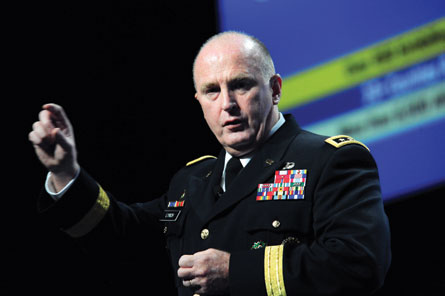Lt. Gen. Rick Lynch said he has seen progress in the development of military robotics and unmanned systems, but he'd like to see more, including a renewed push for more autonomous systems.
The United States is worrying about deficits and jobs, but is still fighting two wars. A greater use of unmanned systems is one way to cut budgets while still winning conflicts in Iraq and Afghanistan and elsewhere, he said at the opening session of AUVSI's Unmanned Systems North America 2011.
Unmanned systems can help achieve three goals, said Lynch, the commanding general of US Army Installation Management Command and the assistant chief of staff for installation management. They are: improve surveillance; reduce the soldiers' workload; and increase the survivability of service members.
Using small unmanned aircraft can provide an overview, but they don't have enough loiter time to provide "persistent stare," he said, and that's something soldiers need to be able to spot enemy fighters who are placing improvised explosive devices.
 |
|---|
©2011 BillypixLt. Gen. Rick Lynch pins cost-cutting hopes on unmanned |
Greater autonomy can help ease the burden on unmanned systems operators, Lynch said, but too often the military is satisfied with the remotely operated systems of today.
"I used those tele-operated systems, my soldiers did as well, and I thank God for those systems," Lynch said. However, "I believe candidly that we could accelerate the development of autonomous technology" if it's deemed important enough.
"If you want to reduce the workload, and we do, you've got to keep the warfighter in the loop but he doesn't have to be dedicated to that particular mission," Lynch said. He also said he doesn't see a problem with armed robots, which already exist in theater in the form of armed unmanned aircraft and remote-controlled gun stations.
Increasing the survivability of soldiers is the best thing unmanned systems can help achieve, Lynch said, which can partly be achieved by getting more of the technology into the field.
Many soldiers die clearing routes of IEDS in vehicles and "the majority of those vehicles, unfortunately, are manned vehicles, and they don't need to be."
Others die in convoys delivering needed weapons and supplies. "We could have done [robotic] convoy technology a long time ago. We have the technology," Lynch said.
Source: Flight Daily News























